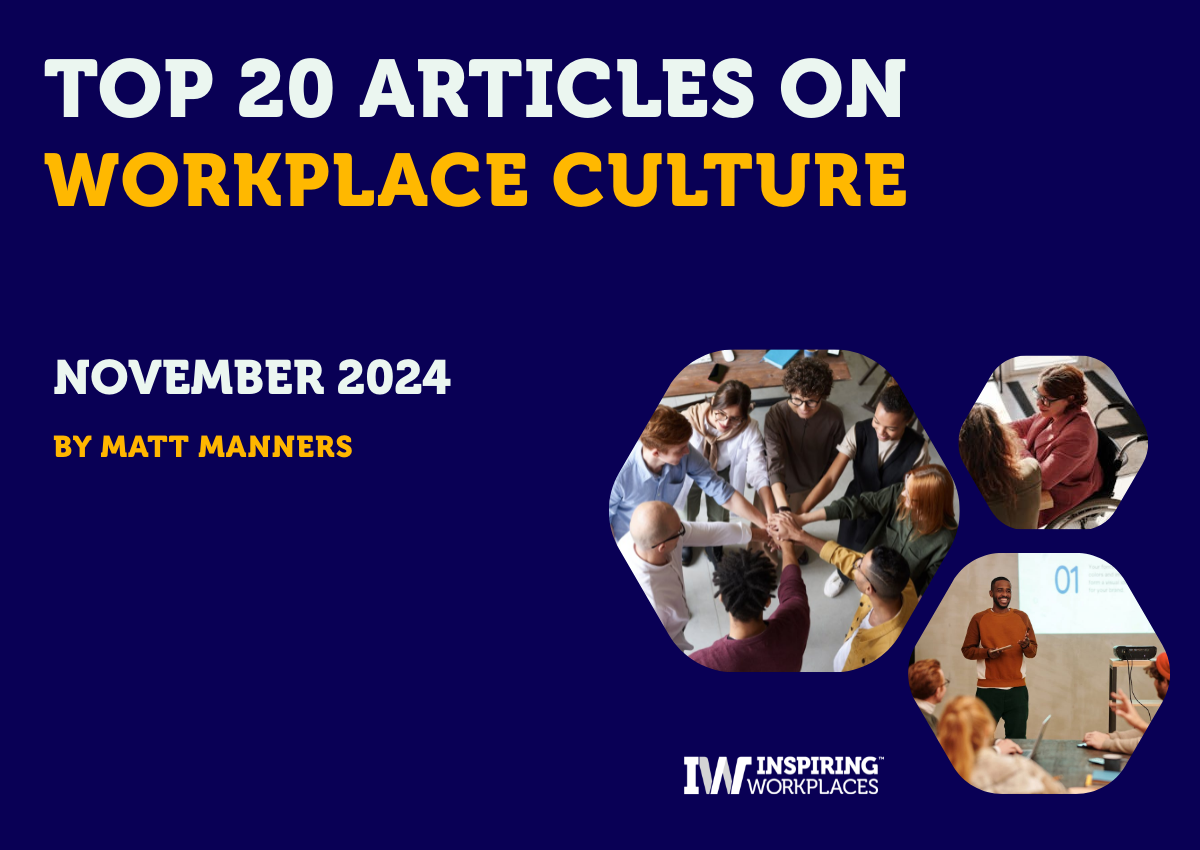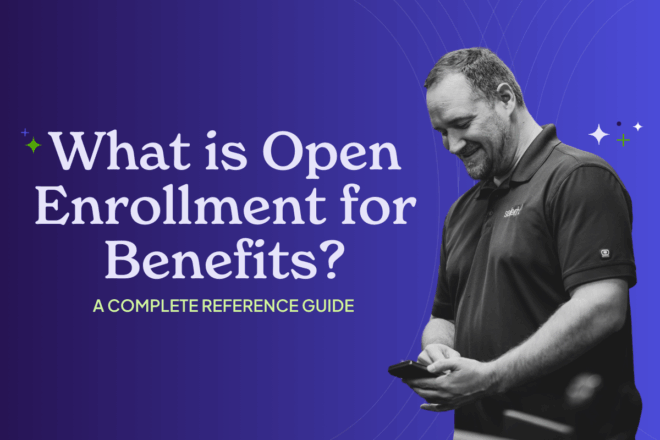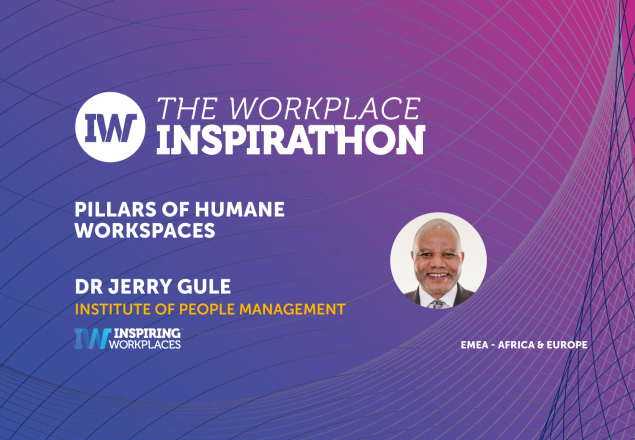
02nd December 2024
Top 20 Articles on Workplace Culture: November 2024

Welcome to the Inspiring Workplaces Top 20 Articles on Workplace Culture for November 2024.
We want to help inform and inspire you from some of the best content out there. Each month we will consolidate these articles for you to help give you a quick and easy snapshot. To help drive you and your organisations forward.
The articles will be underpinned by seven key elements that are reflected in our bespoke COMPASS methodology, that also underpin the Top Inspiring Workplaces worldwide. They are:
- Wellbeing
- Culture & Purpose
- Leadership
- Inclusion
- Employee Experience
- Communication & Voice
- Society & Sustainability
Key Workplace Culture Learnings from November:
- Employee Wellbeing Must Address Organizational Culture: Superficial fixes like apps or mindfulness programs fail without systemic changes in work culture. True wellbeing integrates work design, belonging, and flexibility.
- Transparency and Trust Drive Success: Organizations that prioritize open communication and transparency build trust, boost engagement, and attract purpose-driven talent.
- Diversity and Inclusion Require Action Beyond Hiring: Inclusive practices like clear job descriptions, accessible recruitment processes, and cultural competence training are crucial for retaining and empowering diverse talent.
- AI as a Workplace Partner: AI’s role will evolve from a tool to a collaborator, necessitating ethical frameworks and hybrid human-AI workflows to maintain trust and drive productivity.
- Managers Are Central to Engagement: Line managers play a pivotal role in shaping workplace culture. Training and supporting them to lead empathetically fosters team cohesion and performance.
- Younger Generations Demand Purpose-Driven Workplaces: Flexibility, respect, and alignment with values matter more than traditional benefits, driving the shift toward employee-centered workplaces.
- Workplace Polarization is Growing: Societal and cultural tensions affect organizational dynamics, necessitating inclusive policies and conflict resolution strategies to maintain collaboration.
- Holistic Wellbeing Across Five Dimensions: Career, social, physical, financial, and community wellbeing must be addressed collectively for meaningful impact on employee satisfaction and productivity.
- Inclusivity Enhances Organizational Outcomes: Supporting neurodiversity, flexible work options, and psychological safety boosts innovation, retention, and workplace happiness for all employees.
- Communication is a Leadership Imperative: Frequent, clear, and transparent communication ensures alignment and engagement, especially in hybrid or dispersed work environments.
The articles are as follows…
Despite Employer Prioritization, Employee Wellbeing Falters
Source: Gallup Workplace
Authors: Katelyn Hedrick, Ben Wigert, Ph.D. and Ryan Pendell
IW COMPASS point: Wellbeing
Key Takeaways
- Employee Wellbeing Remains a Top Executive Priority but Faces Challenges: Gallup’s survey reveals wellbeing is a key organizational priority for 23% of CHROs in 2024, yet only 21% of employees strongly agree their organization cares about their wellbeing.
- Gaps Between Promises and Perception Create “Carewashing”: Failure to align wellbeing initiatives with tangible outcomes can frustrate employees, creating a perception of superficial or ineffective support.
- Employee Assistance Programs (EAPs) Need Better Communication and Participation:
- 31% of employees are unaware if their employer offers an EAP.
- Of those aware, 81% have never used the service, highlighting a critical need for improved awareness and accessibility.
- Holistic Wellbeing Requires Support Across Five Core Elements: Employers should expand strategies to address career, social, physical, financial, and community wellbeing, recognizing their interconnected impact on employees’ lives.
- Career Wellbeing is a Crucial Starting Point for Employers: Career wellbeing directly influences overall wellbeing and provides an accessible entry point to integrate work-life priorities.
- Managers Play a Central Role in Wellbeing Conversations:
- Only 36% of employees have discussed wellbeing with their manager, underscoring the need for managers to engage more frequently.
- Managers should encourage wellbeing without needing to be mental health experts, focusing on supportive listening and resource facilitation.
- Increased Wellbeing Conversations Build Trust and Engagement: Encouraging regular discussions about wellbeing at work fosters a culture of care and demonstrates organizational commitment to employee needs.
- Wellbeing Investments Yield Substantial Benefits: Employees who believe their organization cares about their wellbeing are:
- 4.4x more likely to be engaged at work.
- 7x more likely to recommend their organization as a great place to work.
- 73% less likely to feel burned out frequently.
- 53% less likely to seek new job opportunities.
- 50% more likely to thrive in life.
- Sustainable Wellbeing Culture Requires Collaboration: A thriving wellbeing culture is driven by consistent actions and conversations across all organizational levels—from leaders to frontline employees.
Read the full article here
Why Employee-Centered Workplaces Have Stronger Business Outcomes
Source: Forbes
Author: Julie Kratz
IW COMPASS point: Employee Experience
Key Takeaways
- Younger Generations Hold Greater Power: Employers must adapt to rapidly shifting workforce demographics, focusing on equitable power distribution and inclusive leadership to meet younger employees’ changing needs.
- Purpose Over Paychecks: Employees, especially younger generations, prioritize purpose, respect, flexibility, and autonomy over traditional benefits, demanding workplaces aligned with their values and lifestyles.
- Proven Business Benefits of Employee-Centered Workplaces:
- Companies excelling in mutualistic relationships see better valuations (55%) and profitability (51%).
- Firms innovating in employee benefits report higher profit margins (54%) and valuation performance (56%).
- The “Win-Win Workplace” Framework:
- Openness to Listening: Going beyond suggestion boxes to genuinely hear employee voices.
- Inclusive Decision-Making: Involving employees in meaningful ways and leveraging technology.
- Mutualistic Relationships: Prioritizing a partnership approach where employers serve employees.
- Ownership Culture: Empowering employees and centering their experience.
- Deep Talent Pipeline: Shifting hiring practices to focus on inclusivity and long-term development.
- Case Study – Discover Financial Services:
- Establishing a call center in Chicago’s underserved south side demonstrated how prioritizing employees leads to tangible outcomes, including:
- A 40% higher retention rate than other centers.
- Significant local economic impact ($12M+ spent on local businesses and contractors).
- Lower turnover, higher productivity, and reduced costs.
- Establishing a call center in Chicago’s underserved south side demonstrated how prioritizing employees leads to tangible outcomes, including:
- Listening Drives Results: Engaging employees in problem-solving fosters innovation, improves engagement, and strengthens business outcomes, as evidenced by Discover and other organizations.
- Small Steps, Big Impact: Even incremental improvements in employee-centered practices yield significant benefits for employees and organizations alike.
Read the full article here
How to Support Your Line Managers to Create an Engaging Culture
Source: LinkedIn Articles
Author: Richard Roberts
IW COMPASS point: Leadership
Key Takeaways
- Line Managers Define Culture: Employees often judge their organization’s culture based on their relationship with their line manager, making their role pivotal to engagement and retention.
- Role Models are Essential: Senior leaders must set an inspiring example, sharing the organization’s vision and purpose with line managers to help them motivate their teams.
- Embrace a Learning Culture: Allowing line managers to fail and learn fosters creativity, empowerment, and resilience, while avoiding a blame culture that can stifle motivation.
- Provide a Development Roadmap: Equip line managers with clear, regularly updated development plans to build their leadership and people-management skills.
- Invest in Coaching and Mentoring: Access to experienced coaches or mentors can build confidence, address challenges, and develop essential leadership skills for new and existing line managers.
- Avoid Misaligned Promotions: Promote individuals with people-management aptitude rather than relying solely on seniority or technical expertise to ensure effective leadership.
- Prioritize Ongoing Support: Creating a supportive ecosystem for line managers ensures they are equipped to inspire, motivate, and lead their teams effectively, fostering an engaging workplace culture.
Read the full article here
The ‘Work Backwards’ Method: Working Smarter and Living Better
Source: People Management
Author: Tim Duggan
IW COMPASS point: Employee Experience
Key Takeaways
- Challenge Conventional Priorities: Shift from “work-money-life” to “life-money-work” to foster a more fulfilling and sustainable relationship with work.
- Address Burnout Epidemic: Recognize the health risks of overworking, as studies link excessive work hours to increased risks of stroke and heart disease.
- Combat Employee Disengagement: With 77% of employees disengaged, adopting a life-first approach can re-engage workers by prioritizing their values and needs.
- Tackle Future Work Anxiety: Address fears around automation and job security by aligning work with meaningful, future-proof goals and adaptable skills.
- Define Personal Fulfillment: Clarify what “enough” means financially and emotionally to reduce unnecessary stress and overwork.
- Embrace the Golden Age of Work Flexibility: Leverage innovations like hybrid schedules, four-day workweeks, and AI tools to reclaim time and improve life quality.
- Improve Work by Prioritizing Life: Paradoxically, focusing less on work often results in greater engagement and productivity during working hours.
- Reframe Introductions: When meeting new people, share passions and dreams instead of just job titles to emphasize life priorities over professional labels.
Read the full article here
Eco-Anxiety, Burnout and Loneliness: Why Sustainability Work Takes a Personal Toll
Source: edie
Authors: Heather Lynch, Katherine Ellsworth Krebs and Shona Russell
IW COMPASS point: Society & Sustainability
Key Takeaways
- Eco-anxiety is pervasive: Sustainability professionals experience grief, fear, and worry due to their deep awareness of climate issues, affecting their mental health and work-life balance.
- Isolation exacerbates challenges: Many professionals work alone in their roles, feeling unsupported by colleagues and organizations, which heightens emotional toll and burnout.
- Organizational obstacles hinder progress: Lack of resources, authority, or senior buy-in often leaves sustainability professionals struggling to drive impactful change while combating greenwashing concerns.
- Soft skills are critical for resilience: Professionals need strong communication, influencing, and self-motivation skills to navigate workplace challenges and achieve sustainability goals.
- Support systems improve wellbeing: Group coaching, peer networks, and access to therapy can provide much-needed support for professionals to sustain their work and mental health.
- Systemic issues require collective action: Sustainability cannot rest solely on a small team or individual; organizations must prioritize collective responsibility for climate and social justice.
- Professional development investments are vital: Organizations should provide budgets for coaching, training, and peer engagement to help professionals overcome challenges and thrive.
- Encourage open discussions: Creating psychologically safe spaces for climate conversations can reduce the burden on sustainability professionals and promote shared responsibility.
Read the full article here
The Nicest Place on the Internet’: How an Australian Business is Trying to Transform Mental Health at Work
Source: BBC Worklife
Authors: Ellie Cobb, featuring Cherie Clonan
IW COMPASS point: Wellbeing
Key Takeaways
- Flexibility Enhances Wellbeing and Productivity: Policies like remote work options, minimal office days, and schedules aligned with employees’ circadian rhythms boost wellbeing and engagement.
- Support for Neurodiversity: Offering accommodations, such as noise-canceling headphones, ADHD assessments, and tailored career paths, creates an inclusive environment for neurodivergent employees.
- Psychological Safety Drives Retention: Establishing a culture where employees feel safe to express their needs reduces burnout and promotes long-term retention, surpassing industry averages.
- Mental Health as a Strategic Priority: Investments in mental health resources, such as life leave days and mental health training, lead to happier employees and better business outcomes.
- Inclusivity Fuels Growth: TDP’s inclusive approach transformed it into a multi-million-dollar business while achieving exceptional staff retention during industry-wide downturns.
- Cost-Effective Inclusivity: Accommodations like autism assessments or support for gender-affirming surgeries cost less than the expense of replacing employees due to turnover.
- Neurodiverse Representation Matters: Promoting neurodivergent employees into leadership roles and challenging stereotypes fosters innovation and inclusivity.
- Leadership with Lived Experience: Leaders with diverse backgrounds and mental health training are pivotal in fostering an inclusive, representative, and psychologically safe workplace.
Read the full article here
We’re Still Lonely at Work
Source: HBR
Authors: Constance Noonan Hadley and Sarah L. Wright
IW COMPASS point: Society
Key Takeaways
- Debunking Common Myths About Loneliness:
- Loneliness isn’t caused solely by remote work; factors like company culture and social opportunities are more significant.
- Team assignments don’t inherently resolve loneliness; strong relationships require deliberate effort.
- Loneliness is not a personal failing; it often reflects broader organizational shortcomings.
- The Role of Culture in Connection:
- Toxic workplace cultures, marked by gossip, bias, or cliques, exacerbate loneliness.
- Inclusive, supportive environments foster belonging and employee loyalty.
- Strategic Social Opportunities:
- Simple activities like communal lunches, happy hours, or meeting time for chitchat enhance connection and reduce loneliness.
- Regularly scheduled, embedded social activities ensure greater participation.
- Prioritizing Relationship Building in Workflows:
- Allow time for meaningful interactions by designing slack into workflows and preventing employee overload.
- Short staffing and excessive workloads hinder social connections.
- Tailored Approaches for Different Work Modes:
- Remote work modes benefit from virtual games, dedicated social channels, and occasional in-person retreats.
- In-person work modes thrive with food-oriented gatherings and collaborative activities.
- Overcoming Resistance Among Lonely Employees:
- Sincere and targeted invitations can engage hesitant employees, fostering trust and participation in social opportunities.
- Actionable Organizational Steps:
- Measure loneliness using tools like the Work Loneliness Scale.
- Focus on improving cultural values and leveraging simple, scalable activities for all employee groups.
Read the full article here
Diversity and Inclusion: Much More than Gender Equality
Source: KHMER Times
Author: Ponlu Tola
IW COMPASS point: Inclusion
Key Takeaways
- Defining Diversity and Inclusion: D&I focuses on creating a workplace where employees feel respected, heard, and valued beyond business strategy.
- Practical D&I Initiatives: Programs supporting women, LGBTQIA+ employees, and mental health include maternity benefits, flexible working, and harassment prevention policies.
- Data-Driven Feedback: Regular surveys, town halls, and engagement scores provide insights into employee needs and guide D&I improvements.
- Leadership Alignment: Inclusive leadership training and aligning D&I with business strategy ensure sustainability and measurable progress.
- Avoiding “Rainbow Washing”: Structural changes and actionable policies outweigh symbolic gestures like Pride celebrations to build genuine inclusion.
- Gaining Leadership Buy-In: Leaders must unlearn biases, create psychological safety, and actively engage in promoting D&I principles.
- Continuous Learning for Leaders: Staying informed about D&I trends through training, research, and community engagement ensures up-to-date, effective practices.
Read the full article here
The Science Of Recognition: Understanding The Psychological Impact Of Leader Praise
Source: Vantage Circle
Authors: Saurabh Deshpande, Sanjeevani Saikia
IW COMPASS point: Leadership, Employee Experience
Key Takeaways
- The Science of Recognition: Praise activates dopamine and serotonin, enhancing motivation, well-being, and the need for social acceptance.
- Impact on Employee Engagement and Productivity: Recognition increases employee engagement by 40% and boosts productivity, as employees repeat excellent performance when acknowledged.
- Fostering Workplace Relationships: Recognition builds trust and camaraderie, fulfilling core psychological needs like belonging, safety, and esteem.
- Job Satisfaction and Retention: Well-recognized employees are 45% less likely to leave their jobs, increasing loyalty and reducing turnover costs.
- Encouraging Innovation and Creativity: Recognition fosters psychological safety, motivating employees to propose ideas, take risks, and innovate.
- Effective Recognition Practices: Praise must be specific, genuine, and timely to reinforce positive behaviors and resonate with employees.
- Tailoring and Inclusivity: Personalize recognition to suit individual preferences and ensure inclusivity to make every employee feel valued.
Read the full article here
5 Behaviors That Demonstrate Highly Effective Leadership
Source: Fast Company
Author: Shirley Davis
IW COMPASS point: Leadership
Key Takeaways
- Consistency Builds Trust: Predictable leaders enhance engagement and productivity by maintaining steady behaviors and aligning actions with words.
- Taking Ownership Promotes Integrity: Admitting mistakes, owning responsibilities, and offering genuine apologies build credibility and reinforce trust.
- Sound Decision-Making Drives Success: Use advisory networks, focus on goals, balance emotions with rationality, and avoid decision paralysis to ensure effective leadership.
- Feedback Enhances Performance: Provide consistent, constructive feedback that motivates employees, fosters trust, and supports professional growth.
- Clear and Credible Communication: Employ the four C’s—clear, concise, consistent, and credible communication—to align teams, set expectations, and build accountability.
Read the full article here
It’s Time to Move Beyond Authoritative Leadership — 3 Ways to Lead with Integrity and Purpose
Source: Enterpreneur
Author: Tracy Marlowe
IW COMPASS point: Culture & Purpose, Leadership
Key Takeaways
- Lead by Example: Leaders must model balance and authenticity, inspiring employees to bring their whole selves to work and personal lives.
- Empower with Purpose-Driven Culture: Connecting work to a larger purpose boosts engagement and productivity. Encourage ownership and align values with organizational missions.
- Prioritize Transparency: Open communication fosters trust. Sharing personal and professional challenges demonstrates vulnerability, strengthening team cohesion and support.
- Trust Fosters Loyalty: Purposeful leadership builds enduring team relationships, reduces turnover, and enhances organizational resilience.
- Compassionate Leadership Over Authoritative Styles: The shift toward empathy and purpose creates a more inclusive, supportive, and effective leadership dynamic.
Read the full article here
When It Comes To Your Company Culture, Think Like An Architect
Source: Forbes
Author: AJ Thomas
IW COMPASS point: Culture & Purpose
Key Takeaways
- Culture as Architecture: Think of company culture as an operating system with layers: mission and values (foundation), team collaboration (application), and goals (features).
- The Operating System: Mission, vision, and values guide decisions and behavior. Misalignment at this level ripples negatively across the organization.
- Transparency Builds Trust: Open communication about decisions fosters belonging, as seen in examples like Pixar’s Braintrust and Patagonia’s activism initiatives.
- Align Purpose and Metrics: Goals and KPIs must reinforce, not undermine, organizational values to avoid metric-driven burnout and disengagement.
- Empowered Teams Drive Success: Teams thrive with autonomy, collaboration, and alignment with organizational purpose, as shown in Spotify’s squad model and Patagonia’s flexible policies.
- Debugging Cultural Misalignments: Addressing systemic issues, rather than patching surface problems, ensures long-term trust, innovation, and employee satisfaction.
Read the full article here
Yes, You’re Diverse – But Are You Inclusive?
Source: People Management
Author: Steph Edusei
IW COMPASS point: Inclusion
Key Takeaways
- Diversity Without Inclusion Is Insufficient: Hiring diverse talent is only the first step; creating a supportive, welcoming environment is essential to retaining and empowering employees.
- Proactive Policy Updates: Revise workplace policies to ensure inclusivity, such as dress codes accommodating protective hairstyles and recognition of diverse family structures.
- Psychological Safety: Encourage open dialogue where employees feel safe to voice concerns, balanced by accountability for respectful and constructive communication.
- Invest in Comprehensive Training: Move beyond unconscious bias training to cultural competence, anti-racism, and LGBTQ+ awareness to equip employees to recognize and combat discrimination.
- Visible and Tangible Changes: Demonstrate inclusivity through physical changes, like gender-neutral restrooms and reflective spaces, ensuring these changes precede diverse hires to avoid tokenism.
Read the full article here
Beyond Implicit Bias: Addressing Toxic Language in The Workplace
Source: SmartBrief
Author: Christopher Bell
IW COMPASS point: Communication
Key Takeaways
- Gendered Language Reduces Equality: Phrases like “you guys” or “chairman” subtly reinforce stereotypes, affecting workplace culture and performance reviews, particularly for women.
- Ableist Terminology Impacts Inclusion: Common terms like “crazy” or “blind spot” unintentionally marginalize people with disabilities, lowering job satisfaction and increasing turnover intentions.
- Exclusionary Idioms Reflect Bias: Phrases with problematic origins (e.g., “sold down the river”) alienate marginalized groups and perpetuate inequities in workplace communication.
- Practical Solutions for Inclusivity: Replace biased phrases with inclusive alternatives, update organizational style guides, and educate employees on the power of language.
- Business Benefits of Inclusive Language: Creating equitable environments through conscious language choices enhances morale, innovation, and profitability, demonstrating respect and fostering trust.
Read the full article here
Good work: what do we know about the quality of UK jobs?
Source: Economics Observatory
Author: Jake Young
IW COMPASS point: Employee Voice
Key Takeaways
- Positive Aspects of Job Quality:
- Employees report strong engagement, work-life balance, and autonomy, supported by flexible work arrangements.
- Core dimensions of good work—pay, wellbeing, relationships, and voice—remain consistent over time.
- Concerning Trends:
- Decreased Work Centrality: Fewer employees see work as central to their lives (47% in 2024 versus 36% in 2019).
- Lower Commitment: A declining willingness to go above and beyond (51% in 2024 versus 57% in 2019).
- Mental Health and Conflict: Significant numbers report work negatively impacts mental health or experience workplace conflict.
- Defining Good Work:
- Includes fair pay, work-life balance, career development, supportive environments, and health and wellbeing.
- Accessibility and inclusivity are key to improving quality for all employees.
- Strategies to Maintain Job Quality:
- Provide clear job roles and expectations.
- Offer resources and feedback to manage job demands effectively.
- Foster supportive leadership to enhance employee value and wellbeing.
Read the full article here
Why a Positive Workplace Culture Can Help to Power Productivity
Source: Business MK
Author: Martin Carmody
IW COMPASS point: Culture & Purpose, Communication
Key Takeaways
- Positive Workplace Culture Powers Productivity
- Respect, equality, and inclusivity create a supportive environment that fosters growth and innovation.
- Stratos prioritizes hiring individuals who align with its culture of care, communication, and collaboration.
- Flexibility and Trust Are Key Drivers
- Flexible working arrangements accommodate personal priorities while maintaining productivity.
- Trusting employees to self-motivate enhances commitment and quality outcomes.
- Importance of Communication
- Open communication ensures all voices are heard, fostering collaboration and collective success.
- Regular feedback and discussions align team goals with organizational objectives.
- Measuring and Enhancing Productivity
- Tracking resource utilization provides insights into team capabilities without micromanaging.
- Incremental improvements, reskilling, and adopting technology boost organizational efficiency.
Read the full article here
Lack of Neurodiversity Inclusion in Hiring is ‘Extremely Worrying’, Says Zurich CHRO
Source: Raconteur
Authors: Sam Forsdick, featuring Steve Collinson
IW COMPASS point: Inclusion
Key Takeaways
- Barriers in Recruitment for Neurodivergent Individuals: 51% of neurodivergent adults hide their condition during hiring due to discrimination and prejudice, highlighting systemic challenges.
- Inclusive Recruitment Practices: Clear job descriptions, flexible interview formats, upfront sharing of questions, and elimination of unnecessary degree requirements level the playing field.
- Supportive Work Environments: Training for all staff, sensory maps, flexible schedules, and part-time options help neurodivergent employees feel valued and supported.
- Broader Benefits of Inclusion: Inclusive practices benefit the entire workforce by fostering better communication, respect, and overall workplace happiness.
- Corporate Responsibility: Companies must align their actions with diversity statements, recognizing neurodiversity as a crucial component of inclusion.
Read the full article here
Why You Can Never Over-Communicate
Source: The Times
Authors: Roisin Currie & Richard Harpin
IW COMPASS point: Communiaction
Key Takeaways
- Frequent Communication Strengthens Engagement: Regular updates help employees feel included and aligned with organizational goals, especially in dispersed or hybrid teams.
- Clarity is Key: Clear, concise communication minimizes misunderstandings and enhances productivity across departments and teams.
- Honesty Builds Trust: Open and transparent communication fosters a culture of trust, empowering employees to contribute meaningfully.
- Adapt to Hybrid Challenges: Effective communication bridges the gap between remote and in-office staff, ensuring everyone remains on the same page.
- Leaders Set the Tone: Leaders must model strong communication practices to inspire and encourage similar behavior across their organizations.
Read the full article here
From AI To Workplace Polarization: Top HR Trends Predicted For 2025
Source: Forbes
Author: Solange Charas
IW COMPASS point: Employee Experience
Key Takeaways
- Transparency vs. Opacity: Companies will divide into “light” (transparent, human-capital centric) and “dark” (minimizing accountability), impacting talent attraction and retention.
- Talent Crisis Deepens: Restrictive immigration policies and workforce gaps will increase labor costs and reduce diversity, necessitating robust internal upskilling and AI integration.
- Private Sector as a Safety Net: Companies will assume greater responsibility for employee well-being as government oversight diminishes, enhancing corporate responsibility initiatives.
- Agentic Workplaces with AI Collaboration: AI will transition from a tool to a collaborator, requiring ethical frameworks and hybrid human-AI workflows for productivity.
- Managing Workforce Polarization: Cultural tensions around DEI and ESG initiatives require inclusive policies, conflict resolution training, and strengthened internal communications.
- Return to Corporate Work: Economic pressures will drive gig workers back to traditional jobs, creating opportunities for companies to adapt to flexibility demands.
Read the full article here
Fifty per cent of employees don’t think shouting at work is bullying
Source: HR Zone
Author: Sharon Aneja
IW COMPASS point: Wellbeing
Key Takeaways
- Shift Focus to Organizational Culture: Effective workplace wellbeing stems from addressing systemic issues, not just individual interventions like mindfulness apps.
- Address Structural Stressors: Poor work-life balance, excessive workload, and lack of flexibility are primary stressors tied to organizational culture.
- Integrate Wellbeing into Work Design: Build human-centered cultures that prioritize employee belonging, flexibility, and energy.
- Practical Interventions:
- Calendar Management: Introduce meeting-free days, shorter meeting durations, and encourage deep work.
- Foster Community: Create intentional moments of connection and provide spaces for rest and recharge.
- Empathetic Leadership: Role model healthy boundaries, set communication norms, and prioritize psychological safety.
- Case Study: VaynerX exemplifies a human-centered workplace, emphasizing empathy and prioritizing people’s wellbeing as a strategic focus.
Read the full article here.






